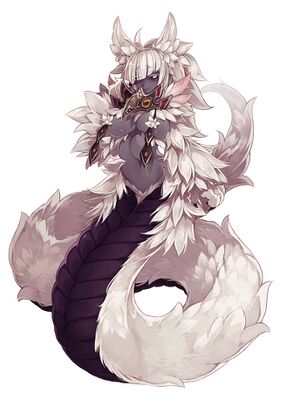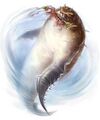Bunyip: Difference between revisions
1d4chan>QuietBrowser (Created page with "{{dnd-stub}} {{NeedsImages}} '''Bunyips''' are one of the very few monsters native to Australia... or at least the ones that anyone can actually name on a first guess. Fo...") |
m (8 revisions imported) |
||
| (9 intermediate revisions by 4 users not shown) | |||
| Line 1: | Line 1: | ||
{{dnd-stub}} | {{dnd-stub}} | ||
[[File:Bunyip 1890.jpg|thumb|Convenient censorship of the groin area, but at what cost?]] | |||
'''Bunyips''' are one of the very few [[monster]]s native to Australia... or at least the ones that anyone can actually name on a first guess. Found in Aboriginal Australian myths throughout the continent, the term basically means "devil" or "evil spirit", but has become particularly associated with a water-dwelling monster. | |||
The precise characteristics are hard to pin down beyond that, both because of its scattered multi-tribal origin and because there are so many different, contradictory accounts of what the bunyip ''is''! Some of the most common descriptions of bunyips are a bizarre predatory mammalian creature resembling a seal, an amphibious dog, or a giant otter, or a bizarre long-necked small-headed "thing". At least one depiction of the bunyip characterizes it as a giant starfish! One of the few common characteristics is a massive booming or roaring call. | |||
Theories as to what inspired the myth include encounters with Australian seals or cassowaries, a now-extinct giant marsupial of some sort, or even just the booming call of the shy, marsh-dwelling Australasian bittern. | Theories as to what inspired the myth include encounters with Australian seals or cassowaries, a now-extinct giant marsupial of some sort, or even just the booming call of the shy, marsh-dwelling Australasian bittern. | ||
| Line 8: | Line 9: | ||
==D&D== | ==D&D== | ||
In [[Dungeons & Dragons]], the bunyip appeared in [[Advanced Dungeons & Dragons]] and was described as a weird combination of seal and shark, being a seal-like mammal with shark-like body and shark-like jaws. They are not evil, just rather playful and mischievous, but the combination of that personality with a big, strong body and a set of jaws that can easily bite off limbs is dangerous. They don't prey on humanoids in general, but small humanoid races such as [[dwarves]], [[gnome]]s, [[halfling]]s and [[goblin]]s are within the size range of their usual prey, so a bunyip that finds one struggling in the water is likely to go with its instincts and try to make a meal. | In [[Dungeons & Dragons]], the bunyip appeared in [[Advanced Dungeons & Dragons]] and was described as a weird combination of seal and shark, being a seal-like mammal with shark-like body and shark-like jaws. They are not evil, just rather playful and mischievous, but the combination of that personality with a big, strong body and a set of jaws that can easily bite off limbs is dangerous. They don't prey on humanoids in general, but small humanoid races such as [[dwarves]], [[gnome]]s, [[halfling]]s and [[goblin]]s are within the size range of their usual prey, so a bunyip that finds one struggling in the water is likely to go with its instincts and try to make a meal. | ||
<gallery> | |||
Bunyip MC3.jpg | |||
Bunyip MCAV3.jpg | |||
</gallery> | |||
==Pathfinder== | ==Pathfinder== | ||
In [[Pathfinder]], the bunyip is also a seal-shark hybrid, but it's much more aggressive and voracious than its AD&D counterpart. There are several noted varieties, including the arctic bunyip, the swamp-dwelling muck bunyip, and the open-ocean-ranging ocean bunyip. | In [[Pathfinder]], the bunyip is also a seal-shark hybrid, but it's much more aggressive and voracious than its AD&D counterpart. There are several noted varieties, including the arctic bunyip, the swamp-dwelling muck bunyip, and the open-ocean-ranging ocean bunyip. | ||
[[Category: Monsters]] [[Category: Pathfinder]] | Despite this being a fantasy world, it took decades to prove without a dought, Bunyips do exist, and even then, most don't believe it. Despite living near humanoids, they don't hunt them unless they enter thier territory. As a node to thier Massive disparity of thier description, they can slightly alter thier forms, replacing thier shredding teeth for a longer tail or crocodile legs. This made it even harder to identify what a bunyip was. | ||
<gallery> | |||
Bunyip PF.jpg | |||
Bunyip PF 2e.png | |||
</gallery> | |||
==Monstergirl Encyclopedia== | |||
[[File:MGE_Bunyip.jpg|thumb|right|300px|Prepare to surrender your snuggles.]] | |||
{{monstergirls}} | |||
[[Monstergirls]] based off of the bunyip are almost unheard of, presumably due to the relative obscurity of the myth and the difficulty in nailing down a single consistent image of it. The [[Monster Girl Encyclopedia]], surprisingly enough, is one of the few that does actually have one. | |||
The MGE bunyip combines elements of the original myth with more reptilian traits, depicting the bunyip as a [[Lamia]]-like mamono covered in massive amounts of waterproof fluff across the majority of her body. Appropriately enough, they live in rivers, typically remaining beneath or just above the water - in a nod to the original myth's inconsistencies, this is noted to make them difficult to identify properly and result in wildly inconsistent descriptions of them in-universe. | |||
They're noted to be particularly shy when around men, to the point where they all but lose the ability to talk and almost inevitably wind up getting overheated with lust before jumping on their lover-to-be, curling around him, and proceeding to screw him silly. They also provide great hugs, even by Lamia standards, courtesy of the super-soft fluffy fur that covers most of their human half and their tail. | |||
[[Category: Monsters]] [[Category: Pathfinder]] [[Category: Monstergirls]] | |||
Latest revision as of 09:42, 20 June 2023

Bunyips are one of the very few monsters native to Australia... or at least the ones that anyone can actually name on a first guess. Found in Aboriginal Australian myths throughout the continent, the term basically means "devil" or "evil spirit", but has become particularly associated with a water-dwelling monster.
The precise characteristics are hard to pin down beyond that, both because of its scattered multi-tribal origin and because there are so many different, contradictory accounts of what the bunyip is! Some of the most common descriptions of bunyips are a bizarre predatory mammalian creature resembling a seal, an amphibious dog, or a giant otter, or a bizarre long-necked small-headed "thing". At least one depiction of the bunyip characterizes it as a giant starfish! One of the few common characteristics is a massive booming or roaring call.
Theories as to what inspired the myth include encounters with Australian seals or cassowaries, a now-extinct giant marsupial of some sort, or even just the booming call of the shy, marsh-dwelling Australasian bittern.
D&D[edit]
In Dungeons & Dragons, the bunyip appeared in Advanced Dungeons & Dragons and was described as a weird combination of seal and shark, being a seal-like mammal with shark-like body and shark-like jaws. They are not evil, just rather playful and mischievous, but the combination of that personality with a big, strong body and a set of jaws that can easily bite off limbs is dangerous. They don't prey on humanoids in general, but small humanoid races such as dwarves, gnomes, halflings and goblins are within the size range of their usual prey, so a bunyip that finds one struggling in the water is likely to go with its instincts and try to make a meal.
Pathfinder[edit]
In Pathfinder, the bunyip is also a seal-shark hybrid, but it's much more aggressive and voracious than its AD&D counterpart. There are several noted varieties, including the arctic bunyip, the swamp-dwelling muck bunyip, and the open-ocean-ranging ocean bunyip.
Despite this being a fantasy world, it took decades to prove without a dought, Bunyips do exist, and even then, most don't believe it. Despite living near humanoids, they don't hunt them unless they enter thier territory. As a node to thier Massive disparity of thier description, they can slightly alter thier forms, replacing thier shredding teeth for a longer tail or crocodile legs. This made it even harder to identify what a bunyip was.
Monstergirl Encyclopedia[edit]

 | This article or section is about Monstergirls (or a monster that is frequently depicted as a Monstergirl), something that /tg/ widely considers to be the purest form of awesome. Expect PROMOTIONS! and /d/elight in equal measure, often with drawfaggotry or writefaggotry to match. |
Monstergirls based off of the bunyip are almost unheard of, presumably due to the relative obscurity of the myth and the difficulty in nailing down a single consistent image of it. The Monster Girl Encyclopedia, surprisingly enough, is one of the few that does actually have one.
The MGE bunyip combines elements of the original myth with more reptilian traits, depicting the bunyip as a Lamia-like mamono covered in massive amounts of waterproof fluff across the majority of her body. Appropriately enough, they live in rivers, typically remaining beneath or just above the water - in a nod to the original myth's inconsistencies, this is noted to make them difficult to identify properly and result in wildly inconsistent descriptions of them in-universe.
They're noted to be particularly shy when around men, to the point where they all but lose the ability to talk and almost inevitably wind up getting overheated with lust before jumping on their lover-to-be, curling around him, and proceeding to screw him silly. They also provide great hugs, even by Lamia standards, courtesy of the super-soft fluffy fur that covers most of their human half and their tail.



